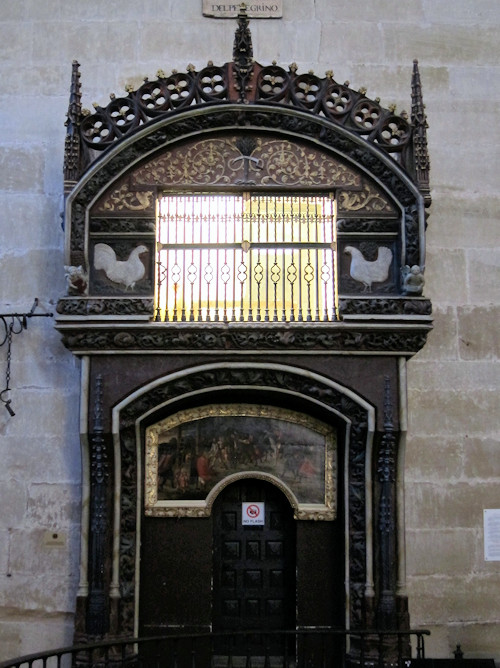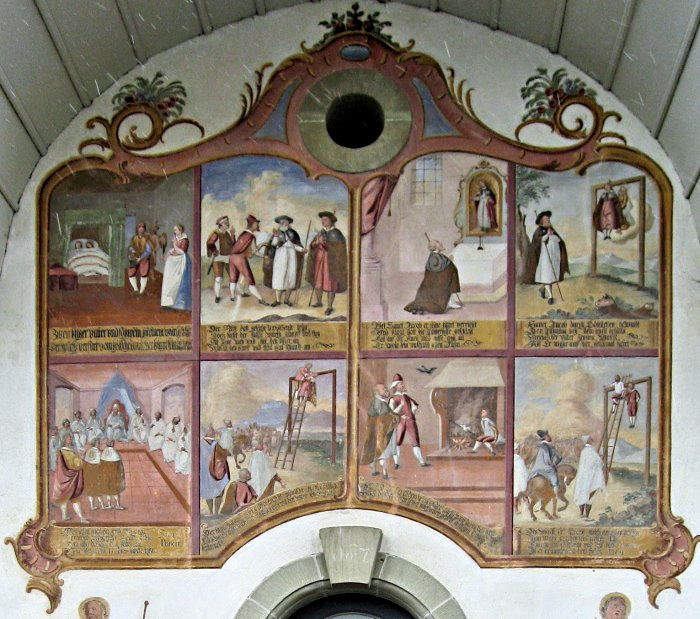Theme with variations

On my pilgrimage through Spain, I finally stood in front of the cathedral in Santo Domingo de la Calzada. So that's where the famous chicken coop was supposed to be? I knew the legend about it. I had also read about the work of the road and bridge builder Dominic of the Road. What was there to doubt? It must have been here, in a hostel in Santo Domingo de la Calzada, where the legend of the "man hanged unhanged", the "gallows miracle" and the "chicken miracle" took place in the Middle Ages:
A legend ...
A landlord's daughter fell in love with a German pilgrim who had stopped at the inn with his parents on their way to the tomb of St. James. The son, however, did not want to know anything about the innkeeper's daughter. As revenge for his spurned love, she put a golden cup in his coat. As she left the inn, she shouted, "Stop, thieves!". Things quickly took their course. The youth was convicted of theft, sentenced and hanged. When the parents concerned came back to Santo Domingo de la Calzada after completing their pilgrimage, they found their son alive on the gallows. "Saint Dominic has held me all this time," said the son. The parents rushed to the judge, who could not believe this and said, "Your son is just as dead as the two roast chickens being served up." No sooner said than the chickens grew feathers, jumped off the spit and fluttered from the table. They all rushed to the gallows. The young man was untied, while the culprit was quickly found. The innkeeper's daughter was hanged instead of the son.
... told differently

I had already encountered the legend in Tafers near Fribourg. On an exterior fresco of the chapel of St. James, you can admire the depiction of the miracle of the chicken, but with a difference: it is not St. Dominic but St. James who supports the boy. Does this mean that the same story also happened in Tafers? Curious, I went in search of other illustrations of the legend of the miracle of the gallows or the chicken. I did not have to look far. In the sacristy of the Augustinian Church in Zurich, which is now a Christian Catholic church, there are remains of wall paintings on this subject. The story that goes with it matches the version from Tafers. In total, I have found 10 places in Switzerland that commemorate the gallows and chicken miracle. I have summarised them on a separate page.

There are also numerous depictions of the gallows miracle and the chicken miracle in South Tyrol, southern Germany and Alsace. From the closer neighbourhood, we would like to mention:
- Constance: Rosgartenmuseum
- Überlingen: Fresko in the Jodok chapel
- Winnenden (twin town of Santo Domingo de la Calzada), former parish church of St. Jakob, today castle church: winged altar
- Rothenburg ob der Tauber, St. Jacob's Lutheran Church: back of the altar of the Twelve Apostles.
- Tramin, South Tyrol: Fresco in the Filial Church of St. Jacob in Kastellatz
- Tschötsch, South Tyrol: Fresco in the Filial Church of St. Jakob in der Mahr (painted in 1461 by the painter Leonhard von Brixen)
- Colmar: Musée d’Unterlinden: winged altar
The multitude of representations is not by chance. The chicken coop in Santo Domingo de la Calzada has always been a sensation, and the legend from the Middle Ages, which quickly spread along the pilgrimage routes, has inspired artists to create depictions in many places. Middle Ages? As recently as July 2002, a large, five-part painting by the priest and artist Sieger Köder depicting the miracle of the chicken was installed on the south wall of the St. James Chapel in Wöllstein. Wöllstein (municipality of Abtsgmünd) is located on the Franconian-Swabian Way of St. James from Würzburg to Ulm.
So the legend still fascinates. But where does it come from? Does the presence of the chicken coop in Santo Domingo de la Calzada prove that the place is also to be regarded as the site of the legendary event? But why was there once also a chicken coop in the Chapel of St. James next to the old Fulda collegiate church to commemorate the miracle of the gallows? In the course of baroqueization, the "Hünnner Hort" was demolished, so that no traces of it can be seen in Fulda today.
In an official list of relics (bull) of Pope Clement VI from 1350, the chicken cage in Santo Domingo de la Calzada is listed for the first time and classified as worthy of veneration. Since the current cage dates from the 16th century, there must have been a predecessor cage.
Oldest lore
The Miracle of the Gallows is narrated in the 12th century miracle book of the Codex Calixtinus (2nd book of the Liber Sancti Jacobi) as the first of a total of 22 miracles that St. James is said to have performed. This oldest version of the legend lists Toulouse as the place of the action, not Santo Domingo. According to this oldest source, the event took place in 1090. The villain is the unfriendly innkeeper, his victims are German pilgrims to Santiago. The daughter of the innkeeper does not appear. The legend is told in the same form in the Legenda Aurea of Jacobus de Voragine, written in 1293. However, there the miracle is already dated to 1020.
In later mentions, the gallows miracle is transferred to Gelferate, today's Belorado. It is only the 13th century Codex Calceatense, preserved in Santo Domingo, that for the first time places the miracle in the town of the road and bridge builder, with the victims being English pilgrims rather than German. Also, it is not James who saves the life of the son, but the local saint Dominic.
In the 15th century, Nompar Seigneur de Caumont embellished the legend. Nompar de Caumont made a pilgrimage to Santiago in 1417 and reported on it in his travelogue "Voiatge a Saint Jaques en Compostelle et a Notre Dame de finibus terrae". For the first time, the innkeeper's daughter appears in it as the person responsible for the evil deed towards the young pilgrim, who is now a German again. The motive for her actions is spurned love.
All the variants of the miracle of the gallows or the miracle of the hen that we encounter as pilgrims of St. James, told or depicted in different ways, have the core of the legend in common: Pilgrims on their journey depend on people of good will to welcome them with hospitality. It is true that hospitality can be refused or abused. But anyone who violates the holy commandment of hospitality for dishonest motives should know unequivocally what punishment awaits him.
Literature: Erich Baierl, "Da sprungen due huener zu hant ab dem spiesz...": die Legende des Galgen- und Hühnerwunders des hl. Jakobus mit besonderer Berücksichtigung der Tradition Frankens. Würzburg: Franconian St. James Society; Volkach: Zentgraf, 2004. 77 p., ill. ISBN 3-928542-56-7.

Fresco in Wöllstein (D)